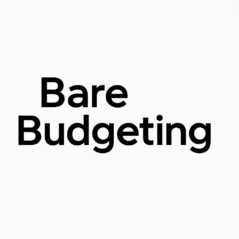Welcome to the method that finally made budgeting not suck.
The Bare Budgeting Method is how I stopped drowning in spreadsheets, ignored every budgeting guru that said I needed six different sinking funds, and actually started saving money. It’s built for people who want a no-BS, minimalist approach to money — one that works even if you’re living on $2K a month.
What Is the Bare Budgeting Method?
It’s simple:
Spend less than you earn.
Make sure every dollar has a job.
And don’t make things harder than they need to be.
This method is built on three pillars:
1. Rule of Thirds Budgeting
This is your monthly budget, broken into three clean categories:
- ⅓ Needs: Rent, groceries, gas, bills.
- ⅓ Financial Goals: Savings, debt payments, investing.
- ⅓ Fun + Flex: Dining out, beer money, gifts, unexpected expenses.
Even on a $2,000 monthly income, this gives you:
- ~$665 for rent and bills
- ~$665 toward building wealth
- ~$665 for lifestyle freedom
It works — because it’s simple enough to follow, even on your worst months.
2. Zero-Based Simplicity
At the start of each month, your income gets divided up until there’s $0 left unassigned.
It’s not about tracking every dollar to death — it’s about giving every dollar a mission.
You can do this using my free Bare Budgeting Google Sheet (download link below), or scribble it out on a napkin. Doesn’t matter — just be intentional.
3. Focus on Flow, Not Perfection
Your money will never be perfectly consistent. That’s fine. The Bare Budgeting Method is designed to flex with life:
- Rent jumped? Pull from the Fun + Flex third.
- Made extra money? Toss it to savings or investing.
- Grocery budget blew up? Cool, don’t spiral — just rebalance.
The goal isn’t to never mess up — it’s to keep the system flowing.
Who This Method Is For
- You hate budgeting apps but love the idea of knowing where your money’s going.
- You live on a low-to-moderate income and want to build wealth anyway.
- You need a method that takes minutes, not hours.
How to Start Bare Budgeting in 10 Minutes
- Write down your monthly income after taxes.
- Divide it into thirds. (Need help? Use the free template.)
- Assign each third to real expenses or goals.
- Stop overcomplicating it. You’re budgeting now.
Real-Life Example (Using $2,000/Month Take-Home)
| Category | Amount | Example Expenses |
|---|---|---|
| Needs (⅓) | $665 | Rent: $500, Groceries: $120, Phone: $45 |
| Financial Goals (⅓) | $665 | Emergency Fund: $200, Roth IRA: $200, Credit Card: $265 |
| Fun + Flex (⅓) | $665 | Restaurants: $200, Gas: $100, Buffer: $365 |
You can tweak the ratio over time, but start with this. You’ll be surprised how far $2K goes when you’re not winging it.
What You Can Expect
- Less guilt about spending — because it’s already built in
- Steady savings and investing — even on a tight income
- Total clarity — you know exactly what your money’s doing
Grab the Free Starter Kit (Google Sheet + Grocery List + Hustle Planner)
Want to plug your income in and get started in 5 minutes?
🎁 Download The Bare Budgeting Starter Kit here →
Includes:
- Monthly budget template (Google Sheet)
- $40/week grocery list
- Side hustle tracker & planner
Final Thoughts
The Bare Budgeting Method isn’t flashy. It doesn’t promise millionaire status overnight.
But it works — especially if you’re broke, busy, and tired of budgeting systems that feel like a second job.
Start with what you have. Use this method. And keep it simple.
